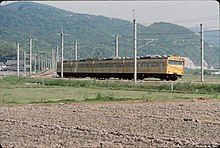|
Fukuchiyama Line
The Fukuchiyama Line (福知山線, Fukuchiyama-sen) is a railway line operated by West Japan Railway Company (JR West) connecting Osaka and Fukuchiyama, Japan. Within JR West's "Urban Network" covering the Osaka–Kobe–Kyoto metropolitan region, the line from Osaka to Sasayamaguchi is also called the JR Takarazuka Line (JR宝塚線). The line traverses the cities of Kawanishi and Takarazuka in the northwestern corner of the Osaka metropolitan area. Although Amagasaki is the line's official southeastern terminus, all trains continue east to Osaka and beyond on the JR Kōbe Line, or to the Gakkentoshi Line via the JR Tōzai Line. Basic data
Services and stations
Local (普通): Stops at all stations, a majority of them operate through services to the JR Kyoto Line, but only these trains stop at Tsukamoto Station. The remaining services operate solely within this line. Rapid (快速): Mainly operates between Osaka and Sasayamaguchi. Some trains operate through services to/from the JR Tozai Line via Amagasaki Station. Among these through trains, some return at Tsukaguchi Station in the non-rush hour. Tambaji Rapid (丹波路快速): Operates between Osaka and Fukuchiyama. Regional Rapid (区間快速): Operates between Osaka and Sasayamaguchi or between Osaka and Shin-Sanda. Also through services to/from the JR Tozai Line and the Gakkentoshi Line.
Rolling stockCurrent
Former
History    The Japanese Government Railways (JGR) opened the Osaka – Kobe section of what is now the Tokaido Main Line in 1874 as a dual track line. The Kawabe Horsecar Railway (川辺馬車鉄道, Kawabe Bashatetsudō) opened a 762mm gauge line between Amagasaki and Itami (about 8 km (5.0 mi)) in 1891. In 1893, the horsecar railway was reorganized as Settsu Railway (摂津鉄道, Settsu Tetsudō), which introduced steam power to the railway and extended the line to Ikeda. The Settsu Railway was merged by Hankaku Railway (阪鶴鉄道, Hankaku Tetsudō), which had a plan to build a railway between Osaka and Maizuru. The Hankaku Railway converted the line to 1067mm gauge and extended it to Takarazuka in 1897 and to Fukuchiyama in 1899. The company also connected the line to the Kanzaki Station (present-day Amagasaki Station) of the JGR line in 1898 making the line to the original Amagasaki terminal a branch. Hankaku Railway was nationalized on August 1, 1907. The Amagasaki – Tsukaguchi section was duplicated in 1934, and extended to Takarazuka in 1979/80. The Takarazuka – Shin-Sanda section was duplicated in 1986 in conjunction with the opening of the 2,970 m (9,744 ft) Najio tunnel and associated deviation, which shortened the route by 1.8 km (1.1 mi). Duplication to Sasayamaguchi was completed in 1996. The Amagasaki – Tsukaguchi section was electrified in 1956, and extended to Takarazuka in 1981. The remainder of the line was electrified in 1986. CTC signalling was commissioned between Fukuchiyama and Sasayamaguchi in 1982, extended to Hirono in 1984 and to Amagasaki in 1986. The branchline between Amagasakikō Station (former Amagasaki terminal of the horsecar railway) and Tsukaguchi Station ceased passenger operation in 1981 and freight operation in 1984. Former connecting lines
AccidentsOn April 25, 2005, a seven-car 207 series train on a Rapid service derailed and crashed into a building between Tsukaguchi and Amagasaki on its way for Doshisha-mae via the JR Tōzai Line and the Katamachi Line. 107 passengers were killed in the accident. Operations on the affected part of the line remained suspended until trial runs began on June 7, 2005. Passenger service resumed on June 19, 2005. The train involved was train number 5418M, a limited-stop "Rapid" commuter service from Takarazuka to Dōshisha-mae. It was a seven-car 207 series electric multiple unit (EMU) formation consisting of a 4-car set and a 3-car set coupled together.[1] The train was carrying approximately 580 passengers at the time of the accident.[1] ReferencesWikimedia Commons has media related to Fukuchiyama Line. |
||||||||||||||||||||||||||||||||||||||||||||||||||||||||||||||||||||||||||||||||||||||||||||||||||||||||||||||||||||||||||||||||||||||||||||||||||||||||||||||||||||||||||||||||||||||||||||||||||||||||||||||||||||||||||||||||||||||||||||||||||||||||||||||||||||||||||||||||||||||||||||||||||||||||||||||||||||||||||||||||||||||||||||||||||||||||||||||||||||||||

